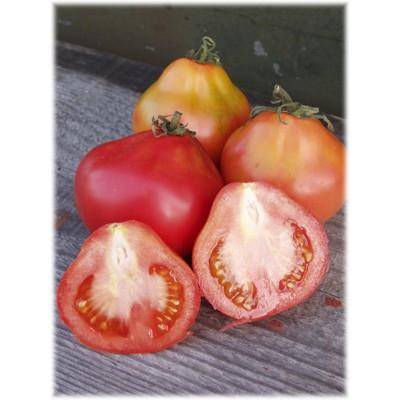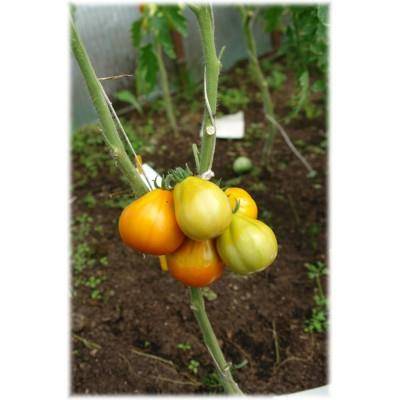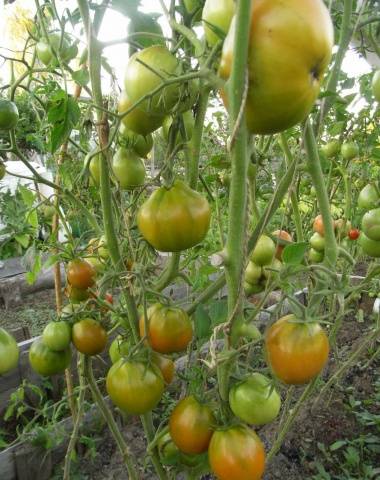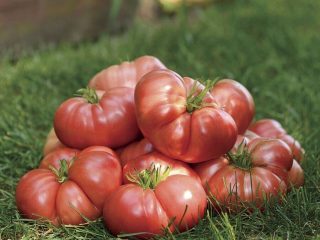Content
The Japanese truffle tomato variety has not yet gained much popularity among gardeners. It appeared relatively recently, but some have already tried the new product. Agree, such an unusual name cannot fail to attract attention. But the peculiarity of this variety is not only in its exotic name. Due to their density, the fruits of the “Japanese truffle” are excellent for various types of preservation. These tomatoes also have an interesting shape that looks like a truffle. For those who have never seen truffles, they will most likely resemble a light bulb.
In this article we will look in detail at the characteristics and description of the Japanese Truffle tomato variety. Each of you will be able to draw your own conclusions whether it is worth growing it or not.
Characteristics and description of the variety
The Japanese truffle tomato is an indeterminate variety. This means that the main stem of these tomatoes can grow continuously. The tomato is not high-yielding. From a bush you will be able to collect no more than 4 kg of tomatoes, on average 2–3 kg. According to the period of fruit ripening, tomato belongs to the mid-season species. From seed germination to the appearance of the first tomatoes, 110–120 days pass.“Japanese truffle” has high disease resistance, so you don’t have to worry about the harvest being lost due to diseases and pests.
This tomato variety is suitable for warm climates. If you live in the northern regions, it is better to plant truffle tomatoes in a greenhouse. In it it can grow up to 2 meters in height, but in open ground only up to 1.5 m. Of course, such tall bushes need staking and pinching. The weight of the fruit can reach up to 200 grams. Tomatoes are pear-shaped with longitudinal ribs. Up to 5 clusters can form on the stem, each bearing 5–6 fruits.
Varieties
Tomatoes of the Japanese truffle variety are divided into several varieties. The characteristics and description of the variety remain unchanged, the types differ in color and have their own taste characteristics. So, the Japanese truffle tomato variety is divided into the following varieties:
"Japanese truffle red"
It is distinguished by a rich red color with a brown tint. The color is very beautiful, glossy. The fruit tastes sweet and has a slight sourness. Excellent for preservation.
"Japanese black truffle"
In terms of fruit shape and general characteristics, it is no different from others. The color is more like brown than black. Has a more refined taste.
"Japanese truffle pink"
There are no special differences. Perhaps the taste is a little sweeter.
"Japanese golden truffle"
It is distinguished by a rich yellow color with a golden tint. The fruit tastes sweet, even somewhat similar to fruit.
"Japanese truffle orange"
Very similar to the golden look. Only the color is deeper, sunny orange.
As you can see in the photo, the fruits have almost the same shape.
All varieties of this variety are suitable for transportation and long-term storage, due to their dense skin. After standing for a while, the tomatoes become even sweeter. Perfect for fresh consumption, as well as for preservation whole and in the form of tomato products.
Growing and care
Tomatoes should be grown in 1-2 stems. When pinching, leave only 5-6 brushes. If you leave more, the fruits will develop poorly. For complete ripening, we leave only 2-3 clusters, and pick the remaining fruits green for further ripening. When grown in a greenhouse, you can get a larger yield than in open ground. The bush will be much taller and there will be more fruits.
Sowing of seedlings begins at the end of March, beginning of April. It should be planted in the ground at the end of May. If you are growing tomatoes in a greenhouse, then you can start at the beginning of the month. Then by mid-June you will be able to collect the first fruits. Seedlings must be planted at a distance of 40 cm from each other. The distance between rows should also be at least 40 cm.
Young stepsons appear very quickly, you need to get rid of them in time. Like all other tomato varieties, it requires moderate watering. It is better to do this in the evening. Leave the water for irrigation to settle; it should not be cold. From time to time, loosen the soil and destroy weed. Don’t forget to ventilate the greenhouse. For better yields, you need to fertilize the soil.
As the characteristics and description of the variety say, these tomatoes have high disease resistance. They tolerate cold well and are not susceptible to fungal diseases. One of them is late blight. It most often destroys the tomato crop. But this will not happen with Japanese Truffle.
Growing Japanese truffle is not difficult at all. As you can see, it is not whimsical and has a fairly good yield. The characteristics and description of this variety guarantee resistance to various diseases. Tomatoes store very well after picking. If you haven't grown these tomatoes yet, give them a try and you won't regret it!
Reviews
Let's sum it up
There are probably few tomato varieties that have such good reviews. Many gardeners have already appreciated the excellent taste of Japanese truffle. We hope these tips will help you grow excellent tomatoes in your garden.





















I also really like truffles, but we prefer yellow and golden truffles to our taste! Next year we’ll try black ones, I haven’t grown them yet.